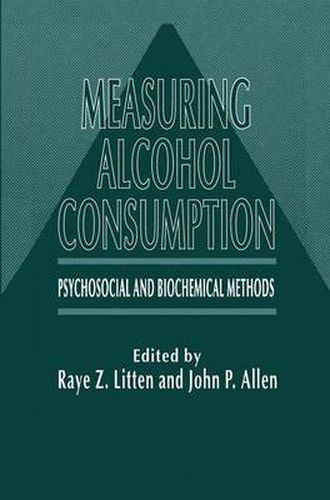Readings Newsletter
Become a Readings Member to make your shopping experience even easier.
Sign in or sign up for free!
You’re not far away from qualifying for FREE standard shipping within Australia
You’ve qualified for FREE standard shipping within Australia
The cart is loading…






This title is printed to order. This book may have been self-published. If so, we cannot guarantee the quality of the content. In the main most books will have gone through the editing process however some may not. We therefore suggest that you be aware of this before ordering this book. If in doubt check either the author or publisher’s details as we are unable to accept any returns unless they are faulty. Please contact us if you have any questions.
Most alcohol studies have focused on the issues of alcohol dependence and the harmful effects of drinking, rather than on the level of alcohol consumption itself. In Measuring Alcohol Consumption, Raye Litten and John Allen - renowned authorities in the field of alcohol studies - and their panel of experts demonstrate how the accurate assessment of alcohol usage is important in its own right. This is especially true in at least four contexts: evaluating the effectiveness of alcoholism and alcohol abuse treatment and prevention efforts assessing the level of alcohol consumption in screening for future alcohol-related behavioral and medical problems determining alcohol consumption - with or without collateral alcoholism - as a risk factor for many serious medical conditions the importance of monitoring alcohol use in ensuring public safety. Measuring Alcohol Consumption discusses a variety of techniques and approaches, including direct verbal and collateral accounts of drinking, complex and innovative biochemical indicators, methods of measuring drinking over an extended period of time, and procedures that measure relatively recent consumption. Timely and thought-provoking, Litten and Allen’s Measuring Alcohol Consumption constitutes the first comprehensive source on these new techniques. It is an invaluable guide for all concerned with the problems associated with alcohol use and abuse, at both the clinical and research levels.
$9.00 standard shipping within Australia
FREE standard shipping within Australia for orders over $100.00
Express & International shipping calculated at checkout
This title is printed to order. This book may have been self-published. If so, we cannot guarantee the quality of the content. In the main most books will have gone through the editing process however some may not. We therefore suggest that you be aware of this before ordering this book. If in doubt check either the author or publisher’s details as we are unable to accept any returns unless they are faulty. Please contact us if you have any questions.
Most alcohol studies have focused on the issues of alcohol dependence and the harmful effects of drinking, rather than on the level of alcohol consumption itself. In Measuring Alcohol Consumption, Raye Litten and John Allen - renowned authorities in the field of alcohol studies - and their panel of experts demonstrate how the accurate assessment of alcohol usage is important in its own right. This is especially true in at least four contexts: evaluating the effectiveness of alcoholism and alcohol abuse treatment and prevention efforts assessing the level of alcohol consumption in screening for future alcohol-related behavioral and medical problems determining alcohol consumption - with or without collateral alcoholism - as a risk factor for many serious medical conditions the importance of monitoring alcohol use in ensuring public safety. Measuring Alcohol Consumption discusses a variety of techniques and approaches, including direct verbal and collateral accounts of drinking, complex and innovative biochemical indicators, methods of measuring drinking over an extended period of time, and procedures that measure relatively recent consumption. Timely and thought-provoking, Litten and Allen’s Measuring Alcohol Consumption constitutes the first comprehensive source on these new techniques. It is an invaluable guide for all concerned with the problems associated with alcohol use and abuse, at both the clinical and research levels.